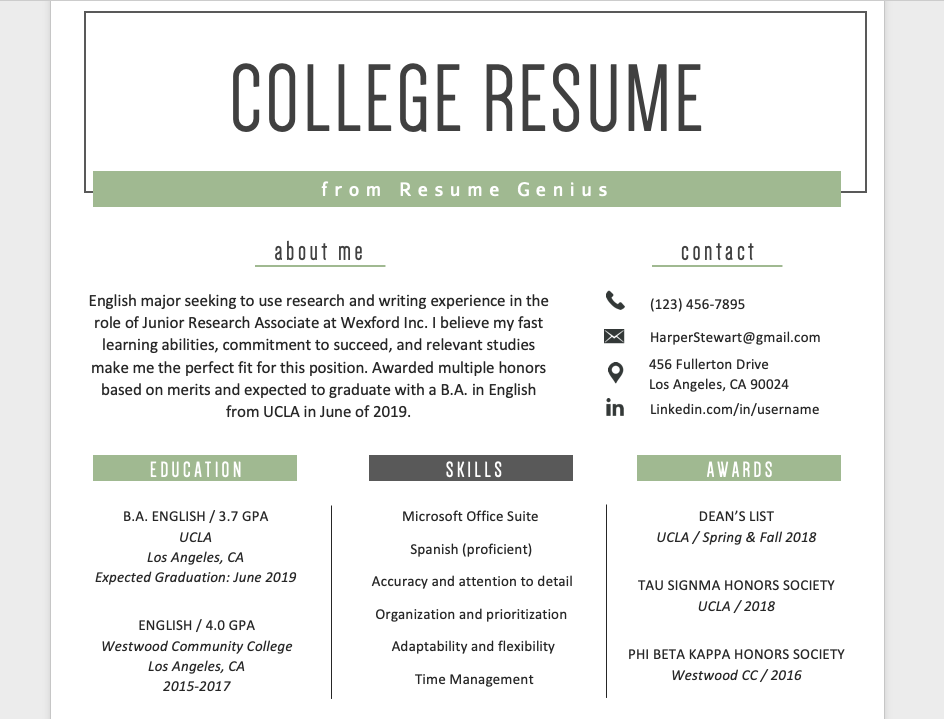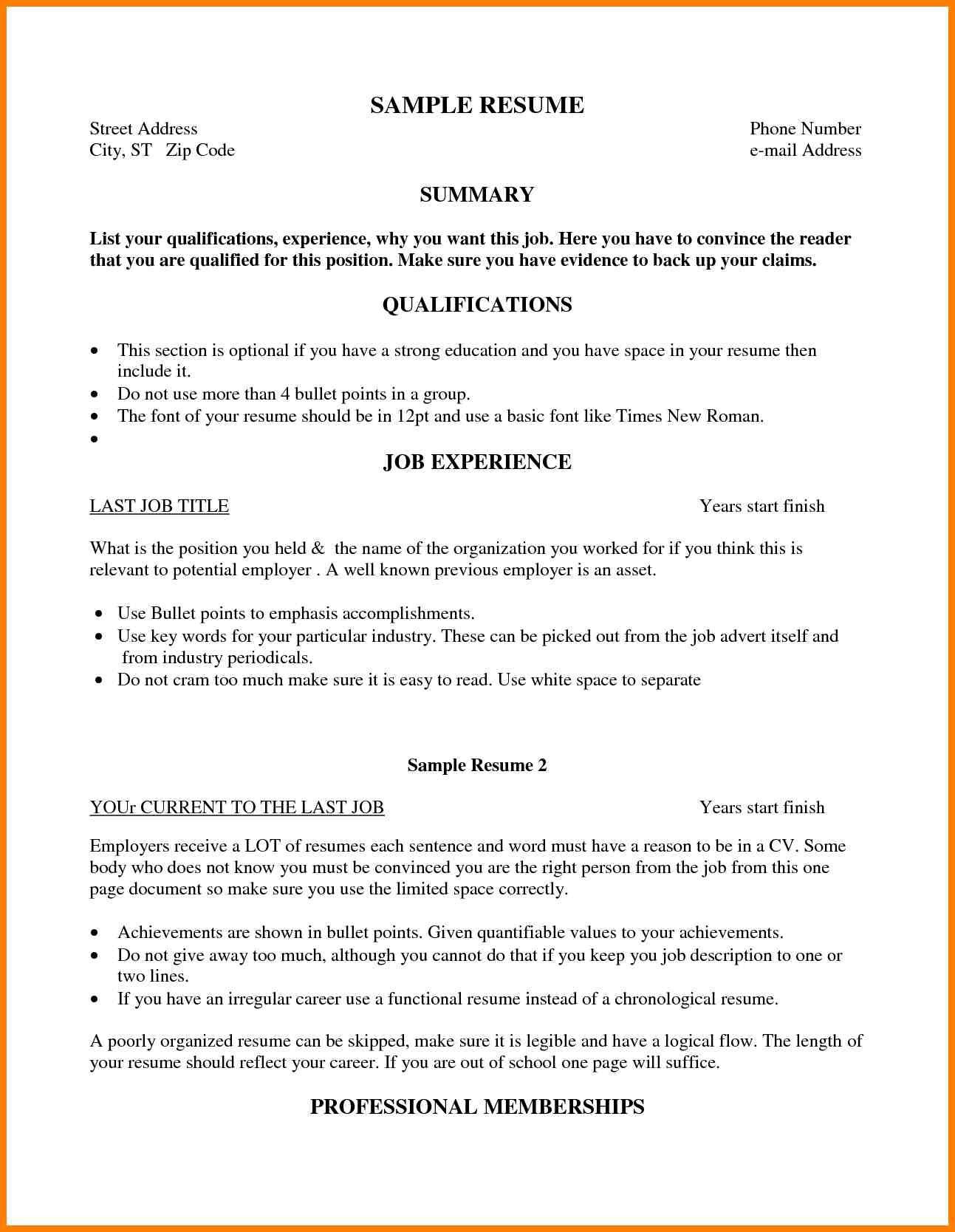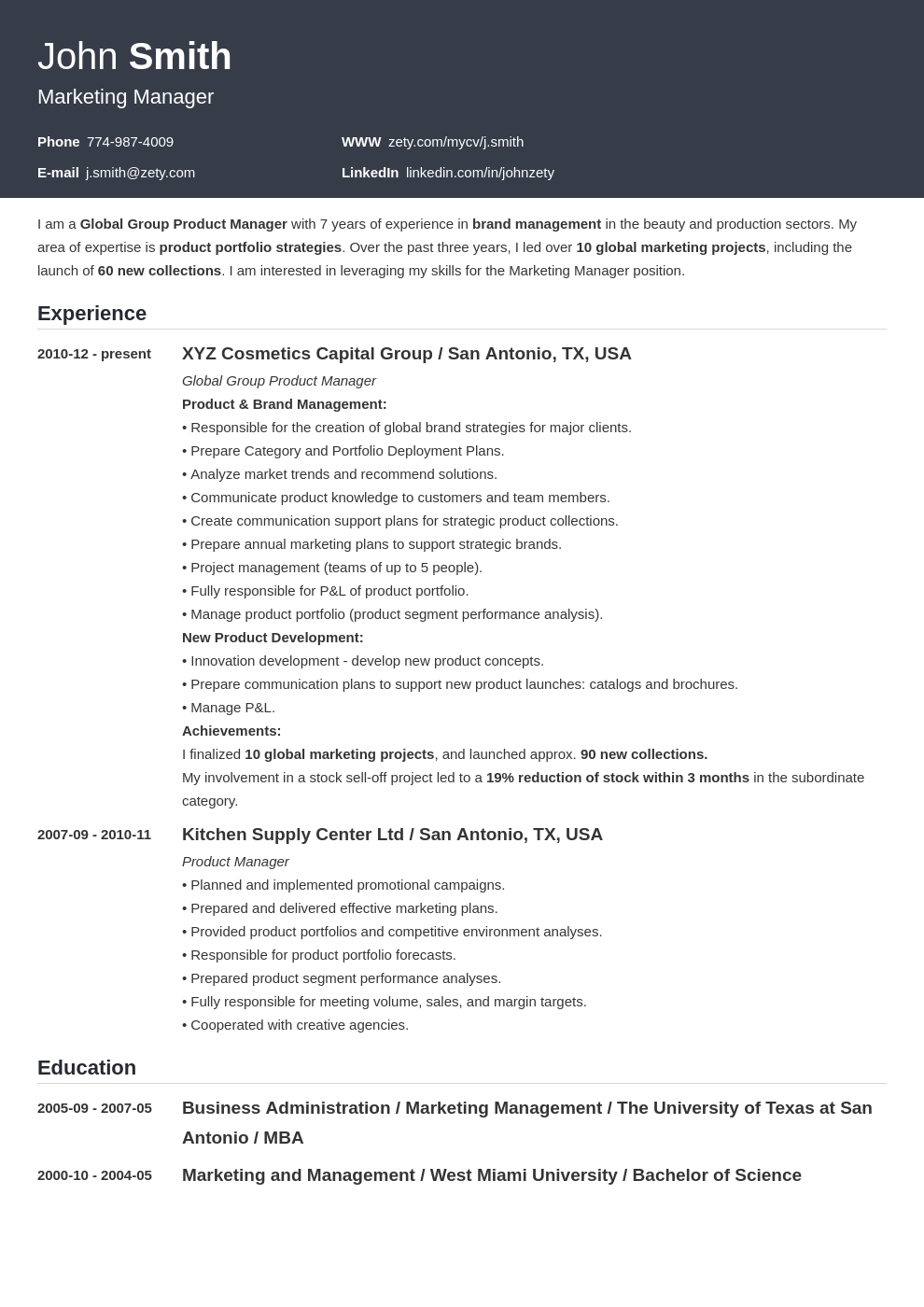Should You Put High School On Resume
If high school is your only education, thats fine!
Just add it as your sole education entry, exactly as in the previous example.
Here is an example of high school education on resume:
Heres how to list GED on your resume:
GED High School Equivalency Diploma
Bronx Adult Learning Center, Bronx, NY
Or a Test Assessing Secondary Completion :
TASC High School Equivalency Diploma
Brooklyn College Adult Literacy Program, Brooklyn, NY
Finally, heres the California High School Proficiency Examination :
CSBE Certificate of Proficiency
Clayton Valley High School, Concord, CA
Expert Hint: We dont recommend dates on finished degrees and diplomas, especially if theyre more than 10 years in the past, but they are useful when the program remains unfinished.
How To Put Study Abroad On Your Resume
Adding a study abroad semester or year to your resume can show employers that youre a go-getter. This information doesnt need to take up much space and should be included in the education section as well.
The correct place to put study abroad on your resume is just below the university you graduated from. You can format it the same way as you format the other institutions attended. For example:
DePaul University, Chicago, IL, December 2009-March 2013
Bachelor of Arts, Major English Composition, Minor Journalism
Università degli Studi di Firenze, Florence, Italy September 2010-December 2010
- Completed coursework in journalism and international affairs.
- Became fluent in the Italian language
Everything you include in your resume should relate back to the job youre applying for. Its good to mention coursework and other activities that apply to that job when including your study abroad experience.
Use A Detailed Format
Alternatively, the detailed format provides more information on the courses you choose to include. This format will look more like what you would typically see under a professional experience section, noting the course and school name, dates you took the course and two to four bullet points highlighting relevant learnings or achievements from the course.
Heres an example:
Ethical Journalism, Fuller School of Journalism, Hartford CollegeFall 2016present
- Understand guiding principles and values of ethical journalism
- Develop and follow a rational process for figuring out your options when faced with an ethics problem
- Justify decisions to editors, colleagues and your audience in year-end
Global Journalism, Fuller School of Journalism, Hartford CollegeFall 2016present
- Learn advanced principles for conducting accurate, effective journalism for a global audience
- Independent year-end study with the opportunity to report from Greece, won honorable mention
Editor, Fuller Times, Hartford CollegeSpring 2015
Related: 27 Proofreading Tips That Will Improve Your Resume
Another decision youll have to make as you work to include a relevant coursework section is where to place it on your resume. If you feel this would simply be a helpful supplement to the rest of your resume for an employer, it might be best placed below the education section of your resume.
Read Also: What Is A Good Typing Speed For Resume
Education For A College Student With No Work Experience
If you are a college student with no work experience, build your education section with your best academic achievements. Include relevant coursework, extracurricular activities, degree, awards and honors, expected graduation date and GPA where applicable.
You can also mention any college experience that applies to the role. Mention the experiences and skills you gained from your coursework or research and how they apply to the role.
Example of the education section for a college student with no work experience:
Bachelor of Science in Psychology, Purdue University, West Lafayette, Indiana
GPA: 3.65/4.0
Relevant Coursework: Experimental Psychology, Cognitive Psychology, Social Psychology
Expected Graduation: September 2019
Awards: Deans List, Autumn 2017
Extracurricular Activities: Assistant Editor of the Purdue Psychology Digest
The best way to make your education section stand out is to keep it honest and relevant. Mention only academic achievements that boost your chances of getting hired. Be strategic and put your credentials where they will attract the hiring managers attention.
As A College Student/recent Graduate

Example:
A recent graduate as used in this context is anyone who graduated less than five years ago. For college students or recent graduates, a detailed educational background is still required since much of what you have to project as your career highlights would be educational achievements or results during the period of enrollment in the institution of study. Some people in this category may, however, have significant work experience so this class will;be divided into two sub-sections.
a. Without work experienceIf you fall into this category, your educational background should come at the beginning of your resume that is, after your contact information and introduction. A more detailed educational background is expected here. Clubs and organizations, relevant course works and information about your final year project as well as academic achievements should be provided if it is relevant to the job youre applying for. A major achievements section may also be added. The section would include information about educational competitions you have been involved in if any and information about your project work may be stated here if it is not relevant to the job in view. You should frame the information provided such that it depicts you as an active person with interpersonal, organizational and leadership skills.
You May Like: How Much Job History On Resume
What To Include In This Section
You can include any of the following in this part of your CV:
- Academic results, degrees, diplomas and certificates
- Technical and professional qualifications *
- Work and vocational training received *
Studies that you can list in this section include:
- Undergraduate and postgraduate degrees
- A-Levels, BTECs and other college-level courses
- GCSEs
* Note: If you have a separate Qualifications section, you should include any work or vocational courses/training in that section instead of here.
Location Of The Education Section On Your Cv
A CVs Education section usually comes straight after the Employment or Work Experience section. This is the most common approach adopted by most candidates and favoured by employers.
The following are exceptional cases in which you would place the Education section before the Employment section:
- When having impressive academic qualifications
- When one has recently graduated with little or no work experience
- When applying for a job that especially requires educational excellence
Both of these approaches are correct, and it comes down to your personal choice and preference which format you adopt for your CV.
Read Also: How Many Pages Should A Resume Be 2020
What Are You Most Proud Of Examples
Example Answers For What Are You Most Proud Of?
- Example #1 Entry Level Applicant. The professional accomplishment Im most proud of is graduating in the top 2% of my class from Fordham University.
- Example #2 Associate Applicant.
- Example #3 Management Role Applicant.
- Example #4 Executive Position Applicant.
Structuring Your Education Section On Your Resume
In most cases, your education section only needs to be a line or two underneath your work experience. The longer youve been in the workforce, the shorter it should be. Your education section should list what school you attended and what degree you obtained.
If you have multiple degrees, list them in reverse chronological order with the most recent first.
Don’t Miss: How To Build A Acting Resume With No Experience
Why Include An Education Section On A Resume
Theres a good chance that every resume youve ever seen had an education section. But why?
Add Them To Your Resume Introduction
Hiring managers only have seconds to look at each resume.
One of the best ways to immediately grab their attention is by highlighting your relevant resume skills as quickly as possible. Thats where your resume introduction comes in handy.
A strong resume summary summarizes your most valuable skills at the top of the page. This immediately shows employers that you have the base qualifications necessary for the job.
Heres an example of a strong skills-based resume introduction:
Additionally, consider adding a list of core competencies to your resume to quickly communicate your most relevant skills.
Read Also: What Is A Functional Resume Sample
What If You Attended Multiple Schools To Finish One Degree
Only list the school where you graduated or finished yourdegree. Educational institutions require transferring students to submit theirtranscript, along with a detailed list of the subjects they completed withtheir previous school.
Your school records will be consolidated where you graduate,so thats what you should list on your resume. If you put the wrong school, youmay get a negative result from an employers pre-employment background check.
Schools Finalizing Plans As Classes Set To Resumeyour Browser Indicates If You’ve Visited This Link

Area school districts are still finalizing plans for reopening this September. While most have opening days and other details settled, questions remain over the masking issue. Area school officials were contacted by The Post-Journal this week to gauge where districts are at in the reopening process.
The Post-Journal
Don’t Miss: Where To Put Relevant Coursework On A Resume
Listing Incomplete Education On Resume
Incomplete education can be tricky to include in a way that sounds positive â as such, if you have incomplete education, be wary of your wording and avoid words such as âincompleteâ or âunfinished.âInstead try to do the following:
- Include relevant coursework or credits earned during your duration of education before the point of departure from the institution.
- Omit any wordy or lengthy explanations of why the education is incomplete.Â;
However, we’ve seen this be a common problem that many candidates have. Continue reading below to see how to effectively list education that is left incomplete.â
How To List Education On A Resume
Education is one of a few key sections employers look for on resumes. This information will inform interviewers of your background, which can be a helpful way to understand more about your fit for the role. If your education is particularly relevant to the position or includes any credentials that are required for the job, this section may quickly set you apart from other candidates.
1. Name and contact information2. Summary or objectivec. Description of role and achievement4. Education5. Skills6. Optional
You have several options when it comes to choosing where and how you list education on your resume. You can identify the best place to put your education on your resume by carefully reading job descriptions. This will often help you understand whether certain levels of education are essential, nice-to-have or unnecessary for each role.
Read more: 6 Universal Rules for Resume Writing
You May Like: Where Should Skills Go On A Resume
Additional Information And References
Resumes focus on your previous job experiences. However, there may be times when including a skill or accomplishment that was gained outside of your work history could greatly influence a hiring manager. For example, did you win City Volunteer of the Year for your work with a homeless shelter? Or perhaps you have a useful language skill, such as being fluent in Spanish. There is a place for these types of thingsas well as a spot to include references if you chooseon your resume.
In this lesson, you will determine what type of additional information is appropriate to include on your resume.
Watch the video below to learn what to include in the skills section of your resume.
Additional skills and information
Sometimes you may want to include additional information about yourself that comes from outside of your education and work history. For example, you may want to include your fluency in another language, a special community project you coordinated or managed, or maybe even your technology skills outside of what you included in your employment history.
So where do you include additional skills and information on your resume? Here are some options.
References
In most of the United States, your previous managers and the human resources department can only confirm dates of employment, not talk about your performance, so your references should not include previous supervisors.
To improve your chances of getting a job, choose references who:
Try this!
What If Your Degree Is Not Related To Your Job
I know someone who graduated with a degree in design that is nowworking as a life insurance agent, and I know a nursing graduate who worked inIT for years, before becoming a real estate agent. This happens more than youknow, so you shouldnt let this stop you from chasing after your dream job.
Below are two ways to downplay the lack of formal education inyour target job:
- List the relevant coursework in your degree.Lets say you have a Psychology degree, but want a job in marketing. If youtook units in social psychology, communications, grammar, and business, thosesubjects show you have the knowledge required for the job.
- List professional courses or ongoing trainingyou took to compensate for your lack of formal schooling on the subject.
Also Check: How To Make A Resume
How To List High School Education & Geds On Your Resume
If youre a student in high school, the chance is you probably have some volunteer work and extracurriculars under your belt. If these aspects are relevant to the job you are applying for, you can put them before the education section.
In all other cases, the education section would take the upper hand, and would look something like this:
EDUCATION
2015 – 2017
Dissertation: Leveraging User-Generated Content for Advertising Purposes Through Information Systems
Theres a lot more to creating a good resume than just the education section. Become an expert with our complete guide on how to write a resume.
How To List Your Education On A Resume
The education section on your resume is more important than you think. Heres how to structure it, including advice for current students and recent grads.
5 months ago;; 6 min read
The education section is an easily overlooked part of any resume which doesnt mean it should be an afterthought. If youre a current student or recent graduate, or if youre applying to jobs that require a specific degree, youll know you need to put some thought into it, but the same is true even if youve been in the workforce for a while. Here are some of our best tips for how to structure it, including how to make the most impact without letting it take over more space than it needs.
Read Also: Should You Include Your Address On Your Resume
Kicks Two Cents: How To Make Your Education Section Stand Out
How To Write Your Resume Education Section

The education section is among the easiest to write. In most cases, you should be fine if you follow these basic steps:
You can use the following template to write your education section. Naturally, dont forget to only include information that pertains to the job you want.
Dont Be Overly Cutesy
Most of us have stuff in our past that wed like to disguise on our resumes. If it happens that your Achilles heel falls in the education section, be strategic, of course, but not cheesy or dishonest. It probably wont end well. If you feel your education section is a little light, load this section with continuing education and professional coursework.
How To Write A Resume Profile Or Summary Statement
A resume summary or career prole is a brief statement at the top of your resume. If you are a career;changer or have many years of experience, craft a powerful summary to highlight your accomplishments and skills. ;Show;the employer, at a glance, why youre qualied for the job!
Resume Prole Guidelines;
General guidelines to keep in mind:;
- Keep your prole short. Two to ve phrases written in a bulleted form or brief paragraph will do. Think of the summary as a snapshot of your skills, ;accomplishments, and knowledge.
- Label your prole professionally: Summary of Qualications, Career Prole, Career Highlights, Professional Summary, or just Summary or Prole.;
- Place your prole section at the top of your resume page, above your work history, so that the employer can see it when they rst review your resume.